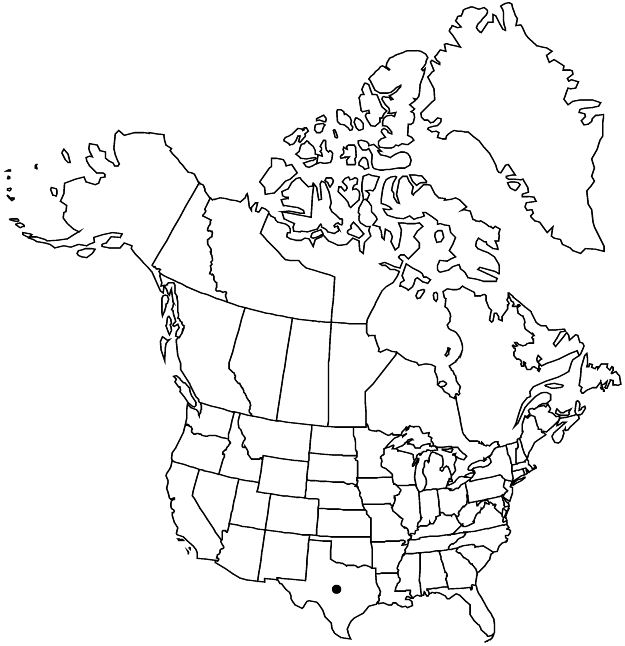Difference between revisions of "Eucnide bartonioides var. edwardsiana"
Phytologia 94: 306, fig. 1. 2012.
FNA>Volume Importer |
imported>Volume Importer |
||
| (6 intermediate revisions by 2 users not shown) | |||
| Line 27: | Line 27: | ||
|elevation=200–300 m. | |elevation=200–300 m. | ||
|distribution=Tex. | |distribution=Tex. | ||
| − | |discussion=<p>H. J. Thompson and W. R. Ernst (1967) called attention to two different floral size morphs among populations of Eucnide bartonioides, and Turner recognized them formally as different varieties. Thompson, in a personal communication to Turner, suggested that the small-flowered var. edwardsiana may be a highly autogamous derivative of the larger flowered form, and observations for this treatment showed the stigma of this form to be closely surrounded by dehisced anthers. Turner indicated that var. edwardsiana, which is found on the Edwards Plateau (Comal, Edwards, Hays, Kerr, Llano, and Travis counties), grades into var. bartonioides in Edwards County. Flowers of var. edwardsiana from Edwards County are at the large end of their size range, and a survey of specimens showed that both relatively large-flowered plants and more typical forms of var. edwardsiana occur near each other in some localities. Turner characterized var. edwardsiana as perennial, but most of the examined specimens appear to be annuals. Across its range in Mexico, E. bartonioides displays variation in flower size, with small-flowered plants that appear to be annuals found in different regions. These are likely to be separate evolutionary origins of small-flowered annuals that converge on the characteristics of var. edwardsiana.</p> | + | |discussion=<p>H. J. Thompson and W. R. Ernst (1967) called attention to two different floral size morphs among populations of <i>Eucnide bartonioides</i>, and Turner recognized them formally as different varieties. Thompson, in a personal communication to Turner, suggested that the small-flowered <i></i>var.<i> edwardsiana</i> may be a highly autogamous derivative of the larger flowered form, and observations for this treatment showed the stigma of this form to be closely surrounded by dehisced anthers. Turner indicated that <i></i>var.<i> edwardsiana</i>, which is found on the Edwards Plateau (Comal, Edwards, Hays, Kerr, Llano, and Travis counties), grades into <i></i>var.<i> bartonioides</i> in Edwards County. Flowers of <i></i>var.<i> edwardsiana</i> from Edwards County are at the large end of their size range, and a survey of specimens showed that both relatively large-flowered plants and more typical forms of <i></i>var.<i> edwardsiana</i> occur near each other in some localities. Turner characterized <i></i>var.<i> edwardsiana</i> as perennial, but most of the examined specimens appear to be annuals. Across its range in Mexico, <i>E. bartonioides</i> displays variation in flower size, with small-flowered plants that appear to be annuals found in different regions. These are likely to be separate evolutionary origins of small-flowered annuals that converge on the characteristics of <i></i>var.<i> edwardsiana</i>.</p> |
|tables= | |tables= | ||
|references= | |references= | ||
| Line 36: | Line 36: | ||
-->{{#Taxon: | -->{{#Taxon: | ||
name=Eucnide bartonioides var. edwardsiana | name=Eucnide bartonioides var. edwardsiana | ||
| − | |||
|authority=B. L. Turner | |authority=B. L. Turner | ||
|rank=variety | |rank=variety | ||
| Line 51: | Line 50: | ||
|publication year=2012 | |publication year=2012 | ||
|special status=Endemic | |special status=Endemic | ||
| − | |source xml=https:// | + | |source xml=https://bitbucket.org/aafc-mbb/fna-data-curation/src/2e0870ddd59836b60bcf96646a41e87ea5a5943a/coarse_grained_fna_xml/V12/V12_802.xml |
|genus=Eucnide | |genus=Eucnide | ||
|species=Eucnide bartonioides | |species=Eucnide bartonioides | ||
Latest revision as of 20:17, 5 November 2020
Herbs, annual (or perennial?), spindle-shaped (wider than tall), sparsely branched or unbranched. Flowers: petals connate to 0.5 mm, 10–25 mm; stamens 15–70, filaments 13–30(–35) mm.
Phenology: Flowering Mar–Nov.
Habitat: Limestone cliffs.
Elevation: 200–300 m.
Discussion
H. J. Thompson and W. R. Ernst (1967) called attention to two different floral size morphs among populations of Eucnide bartonioides, and Turner recognized them formally as different varieties. Thompson, in a personal communication to Turner, suggested that the small-flowered var. edwardsiana may be a highly autogamous derivative of the larger flowered form, and observations for this treatment showed the stigma of this form to be closely surrounded by dehisced anthers. Turner indicated that var. edwardsiana, which is found on the Edwards Plateau (Comal, Edwards, Hays, Kerr, Llano, and Travis counties), grades into var. bartonioides in Edwards County. Flowers of var. edwardsiana from Edwards County are at the large end of their size range, and a survey of specimens showed that both relatively large-flowered plants and more typical forms of var. edwardsiana occur near each other in some localities. Turner characterized var. edwardsiana as perennial, but most of the examined specimens appear to be annuals. Across its range in Mexico, E. bartonioides displays variation in flower size, with small-flowered plants that appear to be annuals found in different regions. These are likely to be separate evolutionary origins of small-flowered annuals that converge on the characteristics of var. edwardsiana.
Selected References
None.
